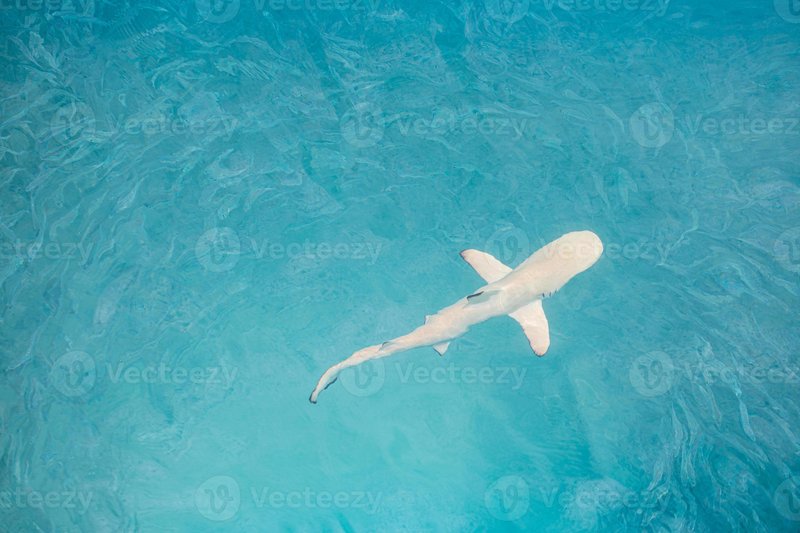
Imagine the ocean, shimmering under the sun, teeming with life. Among the vibrant coral reefs, there swims a creature famed for its sleek silhouette and striking black-tipped fins—the Blacktip Reef Shark. These sharks are not only fascinating to watch but also play a critical role in maintaining the health of their marine habitats. If you’ve ever been curious about these graceful predators, you’re in for a treat. Let’s dive deep into their world!
The Blacktip Reef Shark (Carcharhinus melanopterus) is a member of the requiem shark family and can be found in tropical and subtropical waters throughout the world. Known for their playful behavior and elegance, they are a favorite among divers and marine enthusiasts. But there’s more to these sharks than just their looks. From their diet to their social behavior, each aspect of their life is a fascinating piece of the larger ocean puzzle.
Physical Characteristics
The Blacktip Reef Shark can grow up to 5.5 feet in length, with a streamlined body that allows it to swim swiftly through the water. Their most distinctive feature is the black coloring at the tips of their fins, which gives them their name. This coloration isn’t just for show; it helps them blend in with the shadows of the reefs and evade predators. Their bodies are mostly gray, which helps them camouflage against the sandy ocean floor, making them effective hunters.
These sharks have a tapered snout and large, expressive eyes that enable them to spot prey even in low light. They have a strong jaw filled with sharp teeth, perfect for catching and holding onto slippery fish. The Blacktip Reef Shark is often confused with other reef sharks, but their unique fin markings and slightly smaller size help differentiate them.
| Characteristic | Details |
| Average Length | 5.5 feet (1.7 meters) |
| Habitat | Tropical and subtropical coral reefs |
| Diet | Small fish, crustaceans, and mollusks |
| Speed | Up to 25 miles per hour (40 km/h) |
| Lifespan | 10–15 years |
Habitat and Distribution
The Blacktip Reef Shark thrives in warm, shallow waters, mainly found in coral reefs across the Indo-Pacific region. Their favorite spots include lagoons and rocky areas, where they can hunt and find shelter. They are social creatures and often swim in groups, although these groups can be fluid and changeable. This social behavior is partly due to their hunting strategy, as they often work together to herd schools of fish into tighter spaces.
Interestingly, the habitat of the Blacktip Reef Shark is crucial for its survival. Coral reefs provide not only food but also breeding grounds. Unfortunately, these habitats are under threat from climate change, pollution, and overfishing. Protecting coral reefs is essential for the health of many marine species, including our shark friends.
You might be wondering how these sharks adapt to their environment. They have an incredible ability to thrive in different water conditions, preferring temperatures between 73°F and 82°F (23°C and 28°C). During low tide, Blacktip Reef Sharks can often be seen swimming in very shallow waters, showcasing their adaptability and resilience.
Diet and Hunting Behavior
The diet of the Blacktip Reef Shark is quite diverse. They primarily eat small fish, but they also enjoy crustaceans and mollusks. Their hunting style is an interesting mix of stealth and speed. They often use the element of surprise, darting in quickly to catch their prey. Once they spot a meal, they can reach speeds of up to 25 miles per hour, making them one of the faster sharks in the reef.
What’s fascinating is their hunting behavior. Blacktip Reef Sharks are known to patrol their territory and can often be seen leaping out of the water, a behavior known as “porpoising.” This not only helps them breathe more efficiently while swimming at high speeds but also provides them a tactical advantage over their prey. Imagine being a small fish and suddenly seeing a shark leap through the water—talk about a wake-up call!
These sharks also exhibit a behavior called “cooperative hunting,” where they work with others in their group to corner schools of fish. This social dynamic not only increases their chances of a successful hunt but also demonstrates their intelligence and adaptability in feeding strategies. It’s a beautiful example of how marine life can work together in the rhythm of nature.
Reproductive Behavior
Reproduction in the Blacktip Reef Shark is a fascinating process. They are viviparous, which means they give birth to live young rather than laying eggs. After a gestation period of about 10 to 12 months, females typically give birth to 2 to 5 pups. These pups are about 26 inches long at birth, ready to fend for themselves immediately. It’s a harsh world, but the young sharks are well-equipped to survive.
The breeding season occurs in warmer months, and during this time, males will often engage in elaborate courtship behaviors to attract females. You might see males bumping into females or even swimming closely beside them, showcasing their vigor. Once a male successfully mates, the female will carry the embryos and nourish them through a placental connection similar to mammals, ensuring that the young pups are healthy and well-developed at birth.
One thing to note is that Blacktip Reef Sharks have a relatively low reproductive rate. This characteristic, combined with the threats they face in their environments, makes them vulnerable to population declines. Conservation efforts are critical to ensure that these majestic sharks continue to thrive in the oceans.
Behavior and Social Structure
One of the most intriguing aspects of the Blacktip Reef Shark is its behavior and social dynamics. These sharks are known to be curious and can often be seen interacting with divers and other marine life. Their social structure is not strictly hierarchical; rather, they form loose groups that can change depending on environmental conditions and food availability.
Their social nature is reflected in their cooperative hunting strategies, as we mentioned earlier. They have been observed swimming in coordinated patterns to trap schools of fish, demonstrating both intelligence and teamwork. This collaborative behavior is not only fascinating to witness but also speaks to the complex social lives of these often-misunderstood creatures.
Interestingly, Blacktip Reef Sharks are also known for their playful demeanor. They can often be seen breaching the surface or swimming in circles, which some scientists believe is a form of play. It’s a reminder that sharks, like all animals, have unique personalities and behaviors that make them endlessly interesting to study and observe.
Conservation Status
The Blacktip Reef Shark is currently listed as Near Threatened by the International Union for Conservation of Nature (IUCN). This designation highlights the potential risks they face due to habitat loss, overfishing, and the impacts of climate change. While they are still relatively common in some areas, their populations are declining, making conservation efforts increasingly important.
Many coral reefs, their primary habitat, are under threat from human activities and climate change. Coral bleaching, caused by rising ocean temperatures, poses a significant risk to the reefs that support these sharks and many other marine species. Conservation groups are working tirelessly to protect these habitats and promote sustainable fishing practices to ensure the future of the Blacktip Reef Shark.
As a dive enthusiast or ocean lover, you can help by advocating for marine conservation. Simple actions, like reducing plastic waste and supporting sustainable seafood choices, can make a difference. Every effort counts in ensuring that these beautiful creatures continue to roam the oceans for generations to come.
FAQ
What do Blacktip Reef Sharks eat?
The Blacktip Reef Shark primarily feeds on small fish, crustaceans, and mollusks. They are opportunistic feeders and will take advantage of whatever prey is available in their habitat. Their hunting style, often involving speed and stealth, makes them effective predators in the vibrant coral reef ecosystems where they reside.
How fast can a Blacktip Reef Shark swim?
These sharks are quite fast, reaching speeds of up to 25 miles per hour (40 km/h). This speed is crucial for their hunting strategy, allowing them to catch swift prey and evade larger predators. Their streamlined bodies are designed for quick movements, making them agile swimmers.
Where can I find Blacktip Reef Sharks?
You can find Blacktip Reef Sharks in tropical and subtropical waters across the Indo-Pacific region. They prefer habitats like coral reefs, lagoons, and sometimes even shallow coastal waters. Popular snorkeling and diving destinations where you might spot these sharks include the Great Barrier Reef and the Maldives.
How big do Blacktip Reef Sharks get?
Adult Blacktip Reef Sharks typically reach an average length of about 5.5 feet (1.7 meters). They have a sleek, lightweight body that allows them to navigate easily through their ocean habitat. This size helps them to be agile hunters while still being small enough to evade larger predators.
Are Blacktip Reef Sharks dangerous to humans?
While any shark can pose a risk, Blacktip Reef Sharks are generally considered to be not dangerous to humans. They are known for being curious and often swim alongside divers without aggression. Most interactions with humans are harmless, and they tend to flee when confronted. However, it’s always advisable to respect their space and observe them from a safe distance.
What threats do Blacktip Reef Sharks face?
The main threats to Blacktip Reef Sharks include habitat loss due to coral reef degradation, overfishing, and bycatch from commercial fishing operations. Additionally, climate change leads to warmer ocean temperatures and coral bleaching, further endangering their habitats. Conservation efforts are essential to protect these creatures from being pushed towards extinction.
How do Blacktip Reef Sharks reproduce?
These sharks are viviparous, which means they give birth to live young. After a gestation period of about 10 to 12 months, females can give birth to 2 to 5 pups, which are well-developed and ready to survive on their own. This reproductive strategy is unique and ensures that the young sharks have a better chance of survival in their complex ocean environment.
Can Blacktip Reef Sharks live in aquariums?
While it is possible to keep Blacktip Reef Sharks in aquariums, they require large, specialized tanks that mimic their natural habitat. They need ample space to swim and proper environmental conditions, including water temperature and quality. Most public aquariums are equipped to provide for their needs, but keeping them in private collections can be challenging.
How can I help protect Blacktip Reef Sharks?
You can help protect Blacktip Reef Sharks through various means. Supporting marine conservation efforts, reducing plastic waste, and advocating for sustainable fishing practices are effective ways to contribute. Additionally, educating others about the importance of sharks in marine ecosystems can help raise awareness and promote a healthier ocean environment.

